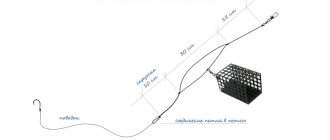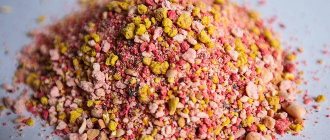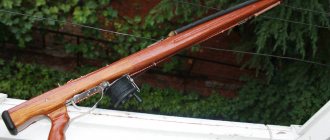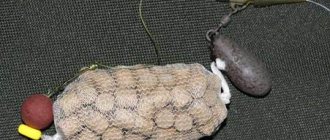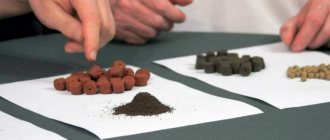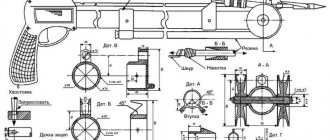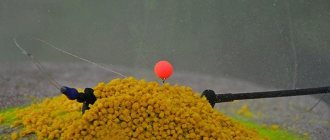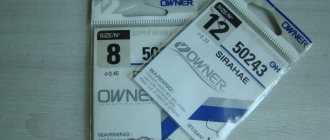Buy quality products at affordable prices in the best fishing online stores
. Give gifts to yourself and your loved ones!
we are in social networks
— subscribe to us on Facebook, Youtube, VKontakte and Instagram. Stay up to date with the latest site news.
Every fisherman knows well: in order to catch fish, you must first feed it well. Complementary food is delivered to the fishing point in many ways. Feeders use large feeders, carp anglers use spods and cobras. Floaters prefer to form balls and throw them with their hands; when feeding over long distances they use slingshots. Thus, the following tools for delivering bait mixtures have been developed in amateur fishing:
- Slingshot (used to deliver small balls of bait over distances of up to 40-50 meters)
- Parachute (made from a plastic bottle and attached to the main fishing line, used for throwing balls 100 meters or more)
- Feeding troughs for the feeder (used for starting feeding)
- Rocket, Spomb (an excellent device for throwing a large amount of bait to the fishing point at close and long distances)
- Cobra (used for feeding the area with boilies)
- Bucket (used for feeding grains, boilies, pellets and other baits)
- Ship (used for delivering food to the fishing point)
- Boats and cutters (used for abundant feeding of fishing points)
These tools will be useful for carp fishermen, bream fishermen, feeders, float fishermen, and bottom fishers. Let's take a closer look at the features of each of them.
Slingshot
Sports fishermen, and more recently amateurs, often use a tool such as a slingshot for feeding fish. It is available in the arsenal of floaters, feeders, bottom fishers and carp fishermen.
The main elements of a slingshot are the rod, rubber, and a cup for bait. With its help, you can easily throw bait balls at distances from 20 to 100 meters. Here are the different types of slingshots:
The fisherman has several types of slingshots. As you can see, each type has different containers for bait. You can add bloodworms with soil to one, maggots with bait to the second, pellets or feeding balls to the third.
Another important element of any slingshot is rubber. It's good to have a slingshot in which you can quickly change the rubber band. They come in different thicknesses and different hardnesses. Tire sets are sold separately in stores. Soft rubber is used for short-distance casting, while harder rubber is intended for long-distance casting.
Note the excellent accuracy of throwing using a slingshot. If you aim, the balls can be placed with an accuracy of 10 cm. For training, it is better to use pebbles of a suitable size. By throwing pebbles at different distances, you can learn how to make accurate throws.
Mixture requirements
For successful fishing, you need to choose the right food, taking into account various factors. The main ones are the characteristics of the reservoir, the time of year, the preferences of the local underwater inhabitants and the weather. The mixture must be balanced and have certain working properties.
Any carp bait includes:
- basic components;
- binders and disintegrants;
- flavorings;
- bite activators;
- animal supplements.
An experienced fisherman skillfully combines ingredients, obtaining working and effective compositions.
Basic components
The following can be used as a feed base:
- porridge or cereals;
- grains;
- pellets;
- dry mixes;
- boilies.
A combination of these ingredients is often used. Many homemade baits contain grains of wheat, barley, millet, and crushed sunflower seeds. Carp also loves corn, so its use in different forms is justified.
Binders and disintegrants
In order for complementary food to have the correct consistency, not break when hitting water and begin to disintegrate at the bottom, forming an attractive spot, it is necessary to add binding and loosening components to it. Without them, it is impossible to obtain a high-quality working mixture.
Leavening agents include bread crumbs, bran, cake and milk powder. Breading, as a rule, is added to all bait mixtures. Falling to the bottom, the ball of food begins to “dust”, creating a cloud of turbidity, which can attract carp from a long distance.
Tip: Bread crumbs or bone and krill meal are also used as a leavening agent.
Of the binding components, “Hercules” is often used. Its amount in the mixture depends on the fishing conditions - the presence and strength of the current, depth, relief. The deeper at the fishing point and the more powerful the water flow, the more oatmeal should be added to the bait.
We recommend reading: Bottom tackle for carp
Aromatic additives depending on water temperature
Bait for carp fishing should contain aromatics, which increases its effectiveness and range of action. In warm water, sweet and fruity smells are relevant - raspberry, vanilla, honey, cinnamon. In early spring, late autumn and winter, garlic, anise, dill, and animal protein are used.
Bite activators
This component allows you to significantly increase the number of fish bites. Recently, carp fishermen have been adding various factory-made attractants with pheromones to their complementary food, which can stimulate the activity of carp, even during hours of complete non-biting.
Animal supplements
From living components, small bloodworms are sometimes used, less often maggots or chopped worms. They must be added in small portions, otherwise the fish will quickly become saturated, which will lead to the cessation of biting. During the cold period, it is advisable to increase their number.
Note! Maggots swarming around in the middle of a common pile of food greatly irritates the fish, although it is precisely this that the carp may not eat.
Parachute
A working and budget option for delivering bait is a parachute. This device will allow you to accurately throw bait 100 meters and even further. It is easy to make from a two-liter plastic bottle. The top part is cut off along with the neck. Cutouts are made in it to form petals. The parachute looks like this:

Holes are made on the sides into which a loop and a nylon thread are inserted. A carabiner or swivel is attached to the thread, which is connected to the main fishing line. Any rod that has a test comparable to the weight of the feed is suitable for casting. A spinning reel is attached to the rod. The bait is placed in the bowl and a standard cast is performed. A parachute is convenient for throwing bait balls with the diameter of a tangerine. As you can see, this option is suitable for all categories of fishermen, since it is very cheap.
Photos of DIY bait recipes
Read here - Do-it-yourself winter lure: production, lure, tips on application techniques and nuances of fishing (115 photos)
Feeding troughs for feeder
Before starting feeder fishing, you need to make a starting feeding. For this it is very convenient to use a large-volume feeder. You can do it yourself. Here are the main feeder options:
As you can see, such feeders are several times larger than ordinary ones. They do not weigh much, since the volume of food is large and its weight compensates for the small mass of the feeder. If we used a regular standard feeder when starting feeding, we would have to make 10 casts. Using a feeding trough, we make several casts.
The feeding method is no different from regular casting. After determining a promising point, we clip and throw the feeder into the same place. This method is good because during fishing you can change the feeder to a feeder at any time and add more food to the point.
Rocket
To quickly deliver a large amount of feed to one point, it is convenient to use special rockets such as Spomb. This is a favorite tool of carp anglers. Literally any complementary foods of varying degrees of viscosity are placed in it. These can be boilies, pellets, porridge, bulk bait. The rocket holds from 100 to 300 grams of bait. It looks like this:
As you can see, the food is placed inside the rocket and is hermetically sealed. When it lands on the bottom, it opens and all the food spills out. To deliver 2 kg of bait, on average you have to make 10 casts. The rocket is attached to the main line of the carp fishing rod via a carabiner. On average, rockets weigh 60-80 grams. The spomb is usually attached to a spod rod with 200 grams of dough.
Conventional missiles of this type are also used:
They hold approximately the same volume of feed as spod rockets. However, when it falls, the food does not spill out immediately. So that it remains at the bottom, after the rocket lands, the rod is sharply raised up several times, as feeders do when starting feeding, and the food will fall out of the rocket body.
How to make bait for carp at home
Each fisherman has his own treasured feeding recipes. They differ in composition and working qualities, but the basic rules for preparing bait remain the same:
- The basis of any bait is cereal ingredients or cereals. Carp also loves peas, corn, and oats.
- Fine components should be used in mixtures. They create dust in the water and do not allow the fish to get enough.
- Carp loves aromatic food, so the use of flavorings and attractants is mandatory.
- You should add components similar to the bait used in the feed.
All ingredients must be fresh. They are prepared in the evening and mixed in the morning at the pond.
Recipe for the feeder
The simplest recipe:
- Soak peas and pearl barley in a 2:1 ratio in water for several hours. Then boil them over medium heat.
- Cook millet and corn porridge in a 1:1 ratio in another pan.
- We pre-soak a kilogram of wheat for 12 hours, and then also cook it in a separate bowl.
- Mix all the cooked cereals in one container.
Arriving at the pond, add flavorings and breadcrumbs. You can use pellets or a store-bought mixture.
Complementary foods for different seasons
Depending on the time of year, the composition of carp bait changes. The preferences of fish are influenced by weather, water temperature, and food supply. These factors must be taken into account when preparing for your upcoming fishing trip. Experienced carp fishermen use different food recipes.
For spring
The task of spring bait comes down to awakening the appetite of passive fish, forcing it to approach the feeding point and take the bait. A mixture of available ingredients works well:
- In a 1:1 ratio, pour peas, corn porridge, wheat and millet into a saucepan with boiling water.
- Cook until done, stirring constantly.
- At the end of cooking, add 150–200 grams of sugar to the resulting porridge, cover with a lid and leave to cool.
- At the pond, add some aromatic black bread and garlic to the mixture.
- We use cake or semolina as a leavening agent.
Recommended reading: Fishing with a popper
Since in spring carp needs an increased amount of protein, we add bloodworms or finely chopped worms to the bait.
For summer
In summer, carp often go to shallow water, stay in the upper horizon, and prefer sweet smells. Here is a well-proven mixture recipe that even a novice angler can implement:
- Mix egg powder, soy flour and milk powder in a ratio of 1:2:3.
- Add breadcrumbs to the mixture.
- We use sugar and honey and a little cinnamon as flavorings and sweeteners.
We finally prepare the bait on the shore.
For autumn
In autumn, the requirements for carp bait are similar to those in spring. Carp needs an increased amount of protein, is often passive, feeds on exits, stays at medium and great depths, and moves little. A good recipe that experienced anglers like:
- Pour boiling water over the pearl barley and let it brew for about two hours.
- Mix bran, raisins, chopped peanuts, honey and also pour boiling water for half an hour.
- At the pond, add a pinch of bloodworms or chopped worms to the complementary food.
It is advisable to add a little soil to the mixture. We take water directly from the reservoir.
For winter
In winter, carp bait should not be greasy. It is based on animal components and soil. The simplest way to prepare the mixture:
- Mix the soil with bloodworms and chopped worms.
- Add breadcrumbs or milk powder.
- It is useful to add hemp, flax or poppy seeds.
In winter, you should not get carried away with attractants, so as not to scare the fish away from the fishing zone.
Cobra
Cobras for delivering bait have excellent range and accuracy. With their help, it is easy to throw boilies of various sizes, bait balls, and pellets. They look like a curved tube into the hole of which feeding mixtures are inserted.
The end of the tube has a neoprene or rubber handle. Actually, the name itself was not chosen by chance. The shape of this device resembles a cobra. Another important advantage of cobras is their noiselessness when casting bait. To make the throws work, you need to practice a little, just like with a slingshot.
Good cobras are light in weight and have a thin handle. The material must be durable. The bend of the tool is made in such a way that during the throw the ball of bait rotates in a certain way. In this case, it will fly far and quite accurately.
Tubes of various diameters are available for sale. They are used to throw boilies and balls of various diameters. The most popular cobras are those with a diameter of 18 mm. They allow you to throw boilies ranging in size from 16 to 20 mm far. In order for it to fly well and accurately, the ball is made dense and perfectly round. If you don't get the consistency right, the ball may break apart during flight.
Preparation of feeder bait
When preparing a bait mixture for certain fishing conditions, you need to take into account the consistency of the bait, the particle fraction and its nutritional value.
A good feeder bait should consist of dust particles that attract fish to the fishing point, as well as large particles that retain large fish.
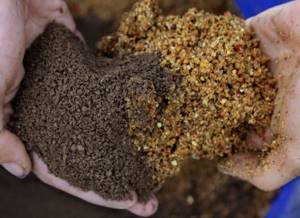
The large fraction includes: bloodworms, worms, maggots, corn grains, cereals, crackers and other large particles of food.
The fine fraction in the bait is dusty and emits a strong odor, which can collect fish from a large area.
The most important rule in feeder fishing is that what is on the hook should also be in the bait. For example, if we fish with maggots, then maggots should also be in the bait. There are situations when dead maggots in bait work better than live ones.
Ladle
An original and effective tool for feeding at close distances is a bucket. This device is used by carp anglers, as well as floaters and bottom fishers when fishing at distances from 15 to 25 meters. There are several types of buckets. Some have a short handle and are used for feeding the coastal zone. The second type has a threaded connection to which the handle is screwed. The images show both options:
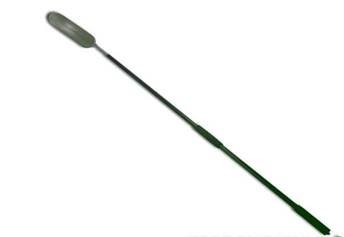
Pellets, cereals, boilies and other baits are placed in such a ladle. A standard bucket holds 300-400 grams of bait:
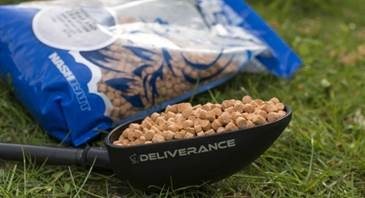
Ship
The most expensive device for delivering bait to a point is a radio-controlled boat. It is capable of transferring 1.5-2 kg of bait at a time. The range of action of the boats is 100 – 800 meters. They are powered by a battery. As a rule, one charge is enough for 3-5 kilometers of distance.
Most models have reverse gear and are equipped with backlighting, which is useful at night. The boat hull is made of durable plastic and metal elements. Some models have two compartments into which bait is poured.
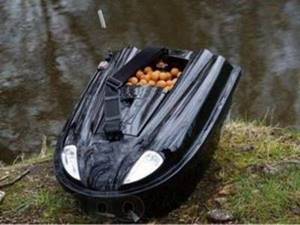
Many modern boats have echo sounders and GPS navigation systems. Such models inform the fisherman about the bottom topography and remember the coordinates of promising places. That is, you receive information about the depth and the presence of fish. Having fed once and memorized the coordinates, the next time you just give the boat the coordinates, and it will swim to the point and throw out the food. Such boats are used mainly by carp fishermen in bodies of water with a small current.
The importance of bait in carp fishing
Feeding the carp allows you to attract the fish to the desired point so that it quickly finds the bait. A mixture selected according to taste and aroma is capable of collecting many individuals and keeping them in the desired area for a long time, which increases the likelihood and number of bites.
In addition, by choosing the color of the bait to match the ground, the angler can create a contrasting spot on the bottom that will stand out against the general background. This will also have a positive effect on attracting fish to the fishing point, making it easier to find the bait and allowing it to be kept there throughout the entire fishing period.
Make or buy
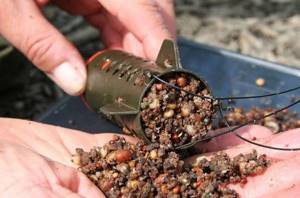
All baits for carp can be divided into homemade and factory-made. The recipes of the former have been known for a long time; they were used by our grandfathers and great-grandfathers, but even today they remain quite effective. The latter were developed by professional fishermen, their production has been put on stream and you can buy ready-made mixtures in every fishing store.
Top 5 ready-made baits for carp
Factory-made carp baits make life much easier for fishermen. With them, you don't have to stand in the kitchen the whole evening before leaving to prepare the mixture. It is enough to take with you the required number of bags of food, mix them in a pond and send them into the water.
However, not all store-bought baits work equally well for carp. Top 5 mixtures that can be recommended to anglers:
- Dunaev Premium Carp-Sazan;
- Traper Big Karp Vanillas;
- Sensas 3000 Super River Carp;
- Minenko PMbaits Carp;
- VDE Carp.
Each rating model is balanced in composition, designed for certain fishing conditions and time of year.
Advantages and disadvantages of homemade mixtures
Do-it-yourself bait allows you to save money while getting a working mixture. The fisherman can choose its composition, independently selecting the optimal components for the given fishing conditions, fish activity, and weather factors.
Recommended reading: Catching burbot with a snitch
On a note! All professional carp anglers know how to prepare their own bait and specifically select components for fishing conditions.
The main disadvantage of homemade food is the length of time it takes to prepare. The fisherman needs to spend the whole evening before going to the pond to prepare all the components of the mixture. You also need to ensure that the product does not deteriorate, otherwise fishing will be ineffective.
